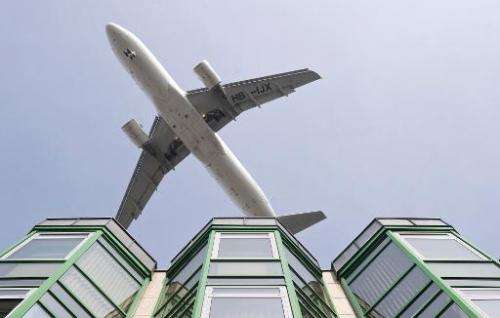Vast majority of EU city dwellers breathe air below UN norms

Emissions of dangerous particulate pollution have fallen in Europe, but a hefty 88 percent of urban dwellers are still exposed to levels that breach UN standards, an official report said on Tuesday.
In its annual report on European air quality, the European Environment Agency (EAA) voiced concern over particulate matter—microscopic specks of dust and soot, caused by burning fossil fuels.
Particulate matter (PM) measuring less than 10 microns, or 10 millionths of a metre, can lodge in the airways, causing respiratory problems.
More perilous still are smaller particles measuring under 2.5 microns across, which can be breathed deep into the lungs and can be so tiny that they even cross over into the bloodstream.
The Copenhagen-based agency said emissions of PM10 had fallen by 14 percent in the EU between 2002 and 2011, and those of PM2.5 by 16 percent.
But 33 percent of the EU's urban population live in areas where pollution levels bust Europe's requirements for maximum exposure to PM10—a benchmark measured on exposure averaged over 24 hours.
"European citizens often breathe air that does not meet the European standards," the EAA said.
"The current pollution levels clearly impact on large parts of the urban population."

The figure rises to 88 percent if the far tougher, but non-binding, guidelines for PM10 set by the UN's World Health Organisation (WHO) are considered.
The EAA also said that 98 percent of European urbanites lived in areas that were above UN guidelines for ozone, a molecule that, at ground level, is caused by a chemical reaction between sunlight and fossil-fuel emissions and is another irritant for the airways.
Separately, a European study published on Tuesday in The Lancet Respiratory Journal found exposure to even low levels of PM2.5 during pregnancy increased the risk of a baby with a low birthweight.
Low birthweight—considered to be less than 2.5 kilos (5.5 pounds) after 37 weeks of pregnancy—is linked to respiratory problems in childhood and cognitive difficulties.
The data come from 14 studies in 12 European countries involving 74,000 women.
The EU has an air quality limit of 25 micrograms of PM2.5 per cubic metre, averaged out over the year.
Every increase of five micrograms per cubic metre raised the risk of low birthweight by 18 percent, the study found.

The increased risk also occurred at levels below the EU limit, it warned.
"The widespread exposure of pregnant women worldwide to urban ambient air pollution at similar or even higher concentrations that those assessed in our study provides a clear message to policymakers," said Marie Pedersen of the Centre for Research in Environmental Epidemiology in Barcelona, Spain.
Particulate matter is at the core of China's problems with air quality, which has been linked to hundreds of thousands of premature deaths.
In one alert in Beijing this year, PM2.5 levels reached as high as 40 times WHO recommended limits.
In September, the Chinese government vowed to reduce concentrations of PM2.5 by around a quarter by 2017 compared to levels in 2012. Other cities on China's affluent east coast will be set reductions of between 10 and 20 percent.
© 2013 AFP

















